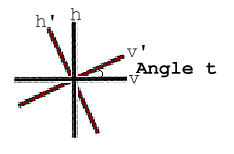

To start with, because a vector projected onto itself has a
magnitude of 1 and a vector projected onto another orthogonal
vector is zero, we have:
At this point, we can choose any solutions for the above projection
amplitudes as long as they collectively satisfy the above equation.
Therefore, we can write each factor as follows:
In this section, we would like to derive the transformations
needed when we want to convert one type of polarization into
another basis. Lets assume that we have two coordinate
systems, one primed and one unprimed, such that the angle
between the systems is "t". In addition to merely changing
the coordinate system of a polarization vector, we will also
want to be able to switch from linear polarization to circular
polarization.

| < Yv|Yh> |2 =
| < Yv'|Yh'> |2 =
| < Yv|Yh'> |2 =
| < Yh|Yv'> |2 = 0
(1)
If we have two coordinate systems as in the figure above, then
we can see that:
|Yh > = |Yh'>cos(t) - |Yv'>sin(t)
(2)
By using the above relationships and by multiplying equation 2 with the
appropriate bra's, one can derive the follwing equations:
< Yv'|Yh> = < Yh|Yv'>
= -sin(t)
< Yh'|Yv> = < Yv|Yh'>
= sin(t)
< Yh'|Yh> = < Yh|Yh'>
= cos(t) (3)
Now, we can choose to expand the v' ket in terms of another basis by
means of the expansion theorem. If we expand onto the circular polarization
basis we get:
and
< Yv|Yv'> =
< Yv|YL< YL|Yv'> +
< Yv|YR< YR|Yv'>
(4)
We know that linearly polarized light is made up of equal parts
of left- and right-circularly polarized light. So,
|< Yv|YL>| = 0.707, as well as the elements
relating v and R, h and L, and h and R. From the relationshps in
equation 3, one can see that equation 4 must equal cos(t). The only
way this is possible is if the projection amplitudes are complex.
< Yv|YR> = 0.707
< YL|Yv'> = 0.707 eit
< YR|Yv'> = 0.707 e-it
(5)
We can now follow a similar procedure to find two more coefficients
by replacing v' in equation 4 with h':
We recognise that, from equation 5, < Yv|YL> =
< Yv|YR = 0.707. Also, since
< Yv|Yh' is sin(t), we find that (again using
the same phase convention) that:
< YR|Yh'> = 0.707ie-it
(7)
The last two elements can again be found by the same procedure.
< YR|Yh'> = 0.707i
(7)
Now, we can use these elements to build a transformation table, noting
that the transpose of each entry is merely its complex conjugate. The
table is:
|Yv> |Yh> |Yv'>
|Yh'> |YL> |YR>
< Yv| 1 0 cos(t) sin(t)
0.707 0.707 < Yh| 0 1 -sin(t) cos(t)
0.707i -0.707i < Yv'| cos(t) -sin(t) 1
0 .707 e-it 0.707 eit < Yh'| sin(t) cos(t) 0
1 .707 ie-it -0.707 ieit < YL| 0.707 -0.707 i
0.707 eit -0.707 ieit
1 0 < YR| 0.707 0.707 i
.707 e-it .707 ie-it
0 1